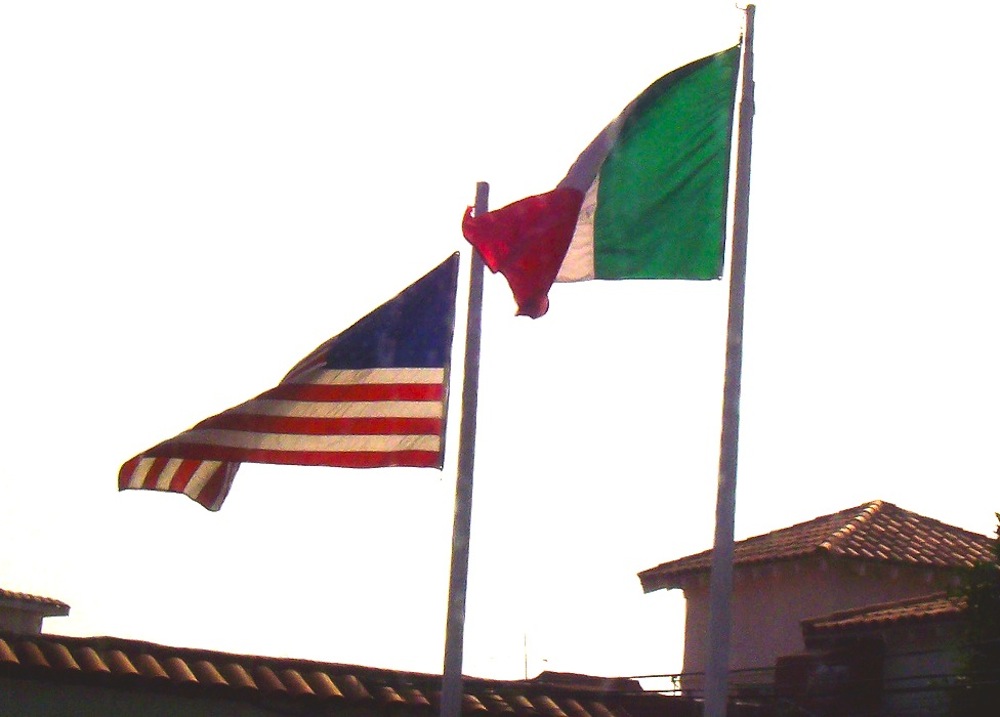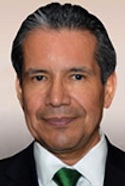
Mexico is becoming a vibrant middle-class nation. Already, it is the largest trading partner of California, Texas and Arizona, and is responsible for hundreds of thousands of jobs across the Southwest.
And that might be just the beginning. With economic and educational reforms underway, Mexico’s rise could accelerate. By one estimate, Mexico will be the world’s fifth largest economy by 2050.
Yes, Mexico faces serious problems of corruption and violence at home. But the country is also investing billions of dollars in infrastructure and transportation near the border. That is already resulting in closer ties between Mexico and the Southwest, with economic, social, and cultural impacts
In advance of the Zócalo/Azteca event, “What Does Mexico’s Economic Rise Mean for the Southwest?”, we asked journalists, scholars, and other experts: What will the emergence of a First World Mexico mean for the Southwest?

The Rio Grande, which once divided the hinterlands of two countries, is becoming the seam that stitches together two of their most dynamic regions. North of the river, the revolution in oil and gas production enabled by hydraulic fracturing (fracking) has produced an economic boom in the land above the 23-county Eagle Ford Shale. Further north, the Texas Triangle bounded by Austin-San Antonio, Dallas-Fort Worth, and Houston is exploding in population and prosperity, as it attracts migrants and jobs from the rest of the country and the world.
Meanwhile, the region south of the Rio Grande is the most prosperous in Mexico. Monterrey, the economic capital of the area, is the second wealthiest city in Mexico, hosting affiliates of multinationals including General Electric and Toyota. The six Mexican states in the Rio Grande Basin—Durango, Chihuahua, Coahuila, Nuevo Leon, and Tamaulipas—have a per capita GDP that is 2.3 times higher than that of the rest of the country. In Mexico as a whole, the middle class has grown to include as much as 40 percent of the population. As rates of Mexican fertility and immigration fall, the Great Migration from rural Mexico to the U.S. appears to have been a one-time phenomenon, like the Great Migration of rural blacks and whites to the northern U.S. between the two world wars.
The continuing challenges of crime and poverty along the border should not obscure the outlines of a historic transformation in North America. The centers of economic dynamism in both the U.S. and Mexico—nations predicted to have the second and fifth largest economies in the world by 2050—are converging at la frontera. A new transnational core in the global economy, like the Benelux nations of Europe and the concentration of wealth in East Asia, is emerging on both sides of the area between the Rio Grande and Nueces rivers once known as the Wild Horse Desert. In an age obsessed with bad news, this is very good news indeed.
Michael Lind is co-founder of the New America Foundation and author of Land of Promise: An Economic History of the United States.

In a spectacular glass-paneled building high above Tijuana, Javier Plascencia and his associates mix an assortment of locally grown avocados, beans, corn, and chilis and turn them into creative concoctions that dazzle the eye and the palate at the same time. He is at the forefront of a new culinary movement that has taken Tijuana by storm, gradually transforming the image of a gritty city once known more for its low-end bars, painted donkeys, and gunfights in the streets. Today, tourists from Southern California are more likely to visit the city to sample one of its innovative restaurants, its craft breweries, or the locally grown wines from the Guadalupe Valley just south of Tijuana than to spend the night dancing and drinking in a bar.
As Tijuana has developed over the past 20 years, its relationship to America’s southwest has changed dramatically as well. Not far from Plascencia’s restaurant, Boxell has become one of the leading animation companies on the West Coast, working with Hollywood film studios to produce segments for many of their most popular movies. Another local company, started by a Mexican engineer and an American entrepreneur, produces small drones for the U.S. market, supplying photographers, amateur scientists, and hobby enthusiasts. Still other companies produce airplane parts, medicines, and sophisticated biotechnology. Gone are the days when Tijuana was the television capital of the world, filled with factories that did low-end assembly work. Many of these still exist, but they are increasingly complemented by high-end manufacturing and knowledge production, creating a new symbiotic relationship with cutting-edge industries in the United States.
As Mexico’s middle class has grown—income has increased roughly one-third in real terms over 20 years and educational attainment by 50 percent—Mexico has become a major consumer of goods produced in the American Southwest, from food to technology. All of the U.S. states in the Southwest depend on Mexico as their principal export market; Texas, Arizona, and New Mexico depend overwhelmingly on exports to Mexico for their manufacturing jobs. And there is a new phenomenon of Mexican companies establishing their own factories and production plants in the United States. Sigma Foods, now based in Arizona, has become the largest hotdog and lunchmeat supplier in the United States. Lala Dairies, now based in Texas, is the second largest milk and dairy company in the United States. Once upon a time these were big Mexican companies that supplied the local market in their own country, but they have moved north across the border, creating jobs as they go. Taken together, these changes, all driven by greater prosperity in Mexico, are transforming the way that people in the American Southwest relate to Mexico and vice versa.
Andrew Selee, the executive vice president at the Wilson Center and a former long-time resident of Tijuana, is at work on a book titled Mexico and the United States: Intimate Strangers.

The Southwest is perfectly positioned to benefit from Mexico’s economic growth. Mexico is already Arizona’s largest trading partner, with total trade of $15.9 billion in 2014 alone. These numbers are bound to increase as its economy grows, along with Mexicans’ purchasing power and the rising number of manufacturing facilities in border states. (The Boston Consulting Group estimated Mexico’s labor costs to be 13 percent below China’s in 2014, after adjusting for productivity, and predicted more companies would locate and expand production facilities in Mexico.)
Mexico’s emergence as a leading economy also presents tremendous opportunities for the Southwest beyond trade in physical goods and spending by Mexican tourists. The country’s growing prosperity will enable it to increase investment in infrastructure, education, and research and development.
These enhanced capabilities will allow Mexican companies, institutions, and universities to partner with their Southwest counterparts by addressing issues that are critical to the cross-border region’s future: living and thriving in an increasingly hot and arid climate, managing critical natural resources such as surface and groundwater, and increasing the water efficiency of agriculture and energy production.
That’s good news for the Southwest, because it will mean that the region will no longer be mainly perceived by the rest of the U.S. as a source of undocumented migration and fractious politics, but as an important hub for collaboration with Mexico.
These are much-needed developments, given that some have viewed the Mexican border as a liability rather than the tremendous asset it is (a trend which has overshadowed cross-border collaboration dating back decades between Arizona and Mexico). But the country’s ascent is changing this narrative, and Southwestern states are perfectly positioned to take advantage of the region’s opportunities with Mexico.
Sapna Gupta is a senior policy analyst at the Morrison Institute for Public Policy at Arizona State University.

Northern Mexico and the American Southwest are closer than we think, and economic prosperity on both sides of the border is indispensable for the larger region to fulfill its potential as a booming community. As a native of Chihuahua, Mexico, now living in El Paso, I am very aware that any community with huge inequalities will foster violence and despair.
The emergence of Mexico’s middle class expands the consumption and demand for goods and services offered by U.S. businesses. But it’s also demographically important as a bridge to a more integrated community advocating for a strategy of inclusive growth for all in both countries.
For almost three decades, our business has been helping to share and bring the Hispanic culture to the U.S. by selling Mexican soft drinks and groceries on this side of the border. The Southwest and Northern Mexico are so closely linked we almost don’t think of them as separate markets anymore. During this time we’ve transitioned from a first-generation Mexican consumer, or paisano, to more mainstream consumers starting to incorporate our products into their pop culture. This is no different than the success American consumer brands have long enjoyed in Mexico. Opportunities abound in both directions.
Arizona, California, Texas, and New Mexico should promote themselves more south of the border—not only for tourism and shopping experiences, but as natural destinations for their products, investment opportunities, and financial services. Such promotion will succeed because increasingly more entrepreneurs in Mexico will have greater resources and mobility, meaning more options to choose from. It’s also clear that instead of looking to Washington or Mexico City for answers to our shared challenges, we should be talking to our neighbors on the other side of the border to plot a common course forward.
Alfonso Marquez is director of logistics and manufacturing of Novamex, a leading distributor of Hispanic food and beverage brands.

Mexico is entering the fourth decade of a profound transformation, from a closed, state-dominated economy with an authoritarian political system to an open market economy guided by democratic governance. This process has been punctuated by profound challenges, but Mexico has never veered from its reformist trajectory and has recently reinforced it.
The current administration of President Enrique Peña Nieto is implementing truly revolutionary reforms to enhance economic productivity, growth, and job creation. This includes ending the monopoly of Mexico’s state-owned petroleum and electricity companies and opening the historically sensitive energy sector to private investment; encouraging competition in the pivotal telecommunications sector and throughout an economy long hampered by highly concentrated ownership; restructuring an antiquated education system to build human capital, albeit over time; and strengthening Mexico’s freedom of information act to expose corruption.
These changes will not miraculously make Mexico an advanced industrial economy, but they will significantly boost Mexico in the long term. In the process, they create enormous opportunities for the United States, and especially the American Southwest.
Mexico is the world’s 15th largest economy, estimated to join the top 10 by 2020; it is the world’s 7th largest producer of automobiles and expected to be number six by 2020; and Mexico has free trade agreements with 32 countries, making it a highly attractive production platform for global exporters.
All of this is taking place in a country with deep economic ties to the United States. Mexico is the second largest foreign market for U.S. goods (the U.S. exports more to Mexico than to Brazil, Russia, India, and China combined). Even the goods we import from Mexico have significant U.S. content, a consequence of production sharing, which creates jobs in the United States as well as in Mexico.
The Southwest by itself accounts for over one-third of U.S. trade with Mexico. That translates into 1.5 million jobs, and positions the Southwest to benefit even further from Mexico’s profound yet often underestimated transformation.
Pamela K. Starr is the director of the US-Mexico Network and associate professor of international relations and public diplomacy at the University of Southern California, and senior advisor at ManattJones Global Strategies.

There’s little doubt that the rise of the Mexican middle class spells opportunity for destinations across the U.S., particularly those in neighboring states. More disposable income means more opportunity for luxuries, including travel. As the largest U.S. city in close proximity to Mexico, Houston has definitely reaped the benefits. This is nothing new. Houston’s strong business relationship with Mexico dates back more than a century. A full third of Houston’s residents are from Mexico or are descendants of Mexican immigrants.
Over the last 40 years, we’ve seen a consistent increase in visitation from cities such as Mexico City, Guadalajara, and Monterrey. Now, with the jobs being created by a deregulated Mexican energy industry and other opportunities, we’re seeing new growth. Already Houston sees more international tourists from Mexico than any other country in the world—more than 1 million annually. Just in the last six months, more than 7,000 new airline seats have become available from Mexico to Houston each week on additional flights by Aero Mexico, Interjet, Volaris, and other carriers. That is on top of the more than 500 weekly flights that United Airlines offers to 26 cities in Mexico.
To capitalize on this, we are expanding our advertising and promotional efforts in Mexico this year to reach a target demographic interested in coming to Houston to shop, to see friends and family, and to experience the culture and attractions the city has to offer.
Jorge Franz is senior vice president of tourism for Visit Houston.

Over the last few years, our common border has increasingly become an area of prosperity and regional competitiveness. The border region, defined as the 10 United States and Mexican border states, represents a combined population of nearly 100 million people and constitutes the world’s 4th largest economy. More than $500 billion are traded in goods annually between Mexico and the U.S., which means commercial exchanges of almost $1 million per minute.
Bilateral cooperation is stronger than ever in areas such as infrastructure development, security, and trade. Presidents Enrique Peña Nieto and Barack Obama announced, in May 2013, the establishment of the High Level Economic Dialogue (HLED), to forge a more competitive and dynamic economic relationship between our countries. The HLED establishes cooperation areas under the three broad pillars of promoting competitiveness and connectivity; fostering economic growth, productivity, entrepreneurship and innovation; and partnering for regional and global leadership.
Our countries’ common values and cultural ties are nowhere more visible than at our shared border. As our economy keeps growing, so does our need to create a border that promotes economic competitiveness and enhances security through the secure, efficient, rapid and lawful movement of goods and people. In 2010, our countries issued a Joint Declaration on 21st Century Border Management that acknowledged our shared interests and recognized the need to fundamentally restructure the way we manage our border. Two of our countries’ most dynamic ports of entry are located on the Southwest border with Mexico. The San Ysidro Port of Entry on the Tijuana-San Diego border is the busiest land border crossing in the world; it currently processes an average of 50,000 northbound vehicles and 25,000 northbound pedestrians per day. On the Sonora-Arizona border, the Mariposa Port of Entry serves as the main port of entry for fresh produce entering the U.S. from Mexico and the primary produce distribution point on the southern border.
Much remains to be done, but the level of ongoing cooperation between Mexico and the United States on border issues is a testimony of the maturity and strength of the bilateral relationship. As Mexico continues to advance, so does our commitment to further the integration of the region and the development of both our communities, which have already been intertwined for centuries, towards a stronger global partnership.
Roberto Rodriguez Hernandez is Consul General of Mexico in Phoenix. His trajectory as a member of the Mexican Foreign Service consists of more than 35 years, and in 2002, President Vicente Fox promoted him to the rank of ambassador.



